CPVC fire sprinkler systems are a great option in many settings, but this thermoplastic pipe must be used according to manufacturers’ instructions
Chlorinated polyvinyl chloride (CPVC) pipes and fittings are often used in plumbing and fire protection. They’re a popular alternative to metal because these pipes are lightweight, flexible, simple to cut, don’t need grooving or threading, are less expensive, and are largely impervious to corrosion.
Thermoplastic pipe like CPVC also provides a hydraulic advantage for fire sprinkler system designers. Sprinkler system design depends on water pressure and must account for the friction of the pipe walls against flowing water. NFPA 13’s friction values show that thermoplastic pipe is tied for the highest (most slick) ‘C-value’ with copper tube, brass tube, and stainless steel.
But CPVC also has some special considerations for ensuring its performance and lifespan. You need to protect CPVC from extended exposure to sunlight and high temperatures, install it in protected or concealed spaces, and often use more hangers or support (because it’s flexible). NFPA 13 also limits CPVC fire sprinkler systems to light-hazard occupancies or ordinary hazard installations with situational provisions. In our previous blog posts, you can read more about the use and care of CPVC in fire sprinkler systems and how CPVC stacks up against copper pipes.
One of the most significant considerations when using CPVC is its incompatibility with certain chemicals common in the building trades. In fact, some law firms and claimants have attempted CPVC pipe lawsuits against manufacturers related to these incompatibilities.
But while certain chemicals can contribute to CPVC pipe problems, manufacturers acknowledge and notify buyers of this factor, publishing lists of incompatible chemicals that shouldn’t be used with their products. And when it’s handled, stored, and installed correctly, chlorinated polyvinyl chloride remains a great option for many fire sprinkler systems.
This blog explains a brief history of the legal disputes regarding CPVC pipe problems, the types of chemicals that shouldn’t be used with CPVC pipes and fittings, and how these chemical incompatibilities cause issues.
Need quality fire sprinkler CPVC? QRFS stocks the CPVC fittings and CPVC glue for your next installation.
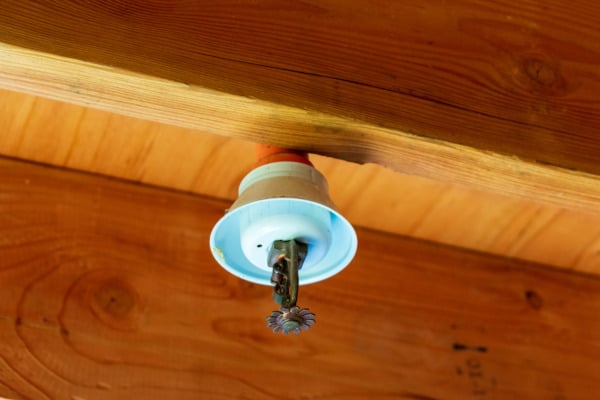
The backstory on CPVC pipe lawsuits
Manufacturers and distributors of CPVC have faced lawsuits alleging failures and consequent property damage.
For example, claimants filed a 2015 class action lawsuit against Lubrizol, the manufacturer of BlazeMaster® CPVC used in fire protection. Other companies named as co-defendants were Allied, Tyco, Viking, Supply Network, Victaulic, Georg Fischel Harvel, Nibco, Spears, Atkore International, and HD Supply Waterworks Group.
The lawsuit alleged that Lubrizol knew its CPVC could fail when used with the wrong chemicals, that the company and its industry partners concealed this information from consumers, and these factors led to significant property damage, primarily in Florida condos. Plastic News summarized the course of events and related allegations, starting with a Lubrizol chemist’s discovery of the issue in 2007. Allied, Tyco, and Lubrizol denied key allegations, however, and a Florida court dismissed the lawsuit without any accompanying settlement and before a class was even certified.
Commenting on the outcome, a group of CPVC manufacturers stated that “the plaintiff’s counsel’s press campaign and claims of a possible billion dollar verdict against the fire sprinkler industry have amounted to sensationalism” and “BlazeMaster pipe and fittings provide safe and reliable fire protection.”
Another law firm filed a similar class action lawsuit against Lubrizol in 2020 over alleged failures of FlowGuard Gold® pipe. Unlike BlazeMaster®, FlowGuard® is used for potable water distribution (plumbing) rather than fire protection. This case has not concluded yet.
Regardless of the specifics of these cases, the fact is that CPVC pipes can become brittle and crack—if they are mishandled and come in contact with the wrong stuff. Because it is a form of plastic, CPVC is vulnerable to anything that disrupts the polymer structure. Enough exposure to UV rays from direct sunlight can do this, as can various chemicals used in the building trades.
Nevertheless, CPVC manufacturers publish explicit lists of chemicals that can and cannot be used in conjunction with CPVC, along with rules for handling, storing, and installing the pipes properly. So, if you are a building owner or resident considering one of these systems, you should vet fire protection or plumbing professionals to ensure they have experience using this material correctly.
How chemical incompatibility works
So, we know that certain chemicals should not be used with or come into contact with this thermoplastic pipe. But this doesn’t mean every one of these chemicals somehow causes a fast rupture 100% of the time. Rather, chemical incompatibility is a spectrum, and it all depends on the foreign substance and the stability of chemical bonds in CPVC.
Michelle Knight, a chemist at Lubrizol, explains that CPVC is an amorphous polymer, which means that the plastic gets its strength from a tangle of molecular chains. The pipe fails when enough chains are broken or untangled to cause a break. There are several possible ways this can happen.
In extreme examples, strong solvents and plasticizers can cause rapid failure of CPVC by themselves. Powerful solvents like tetrahydrofuran, found in solvent cements, actually dissolve the plastic in CPVC pipes and fittings. In contrast, plasticizers like dioctyl phthalate make the pipe soft and too flexible.
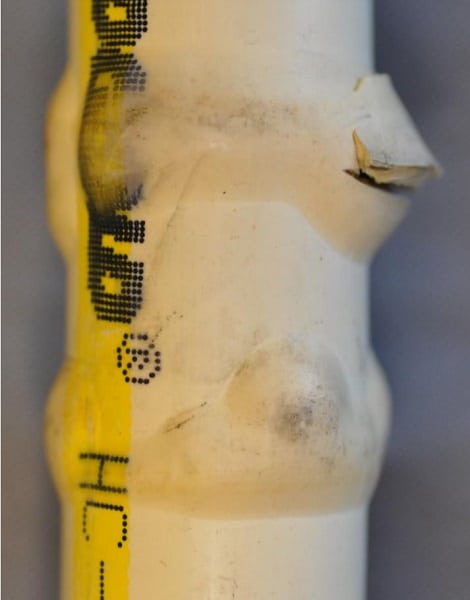
But more commonly, exposure to incompatible chemicals causes slower and more subtle damage. In addition, it often takes a combination of chemical effects and mechanical stress to cause a pipe failure. This is called environmental stress cracking.
Environmental stress cracking
Again, most chemicals incompatible with CPVC don’t cause immediate failure, instead contributing to pipe and fitting failure as one of many factors. The ‘death-by-a-thousand-cuts’ process of environmental stress cracking works something like this:
- The pipe or fitting has some small flaw, which might result from being dropped or struck during transport, prolonged exposure to sunlight, or, less likely, the manufacturing process.
- Then, perhaps the pipe is torqued too much during installation, a connection is made incorrectly, pipe hangers are overtightened, or the pipe is insufficiently supported, causing it to sag and bend.
- Finally, the pipe or fitting is exposed to an incompatible chemical, further weakening the material.
Alone, any one of these factors might not cause a CPVC pipe problem. But a combination of them, along with the stress of holding water under pressure, can lead to a crack or break.
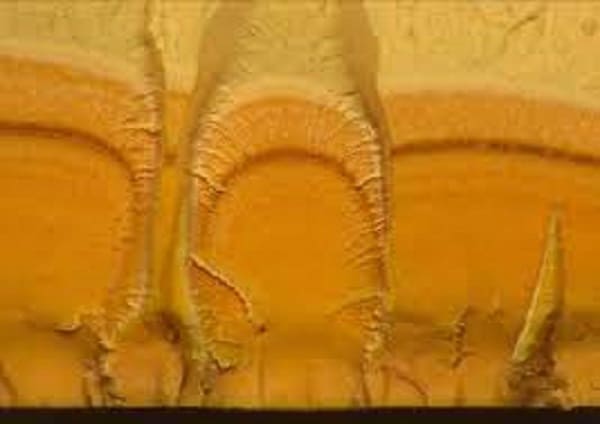
Incompatible products and chemicals that can cause CPVC pipe problems
Various industrial and construction products are incompatible with CPVC. The list includes certain items in these categories:
- Caulks
- Cleaners
- Sealants
- Fire stop
- Pipe clamps
- Pipe tape
- Thread sealants
- Waterproofing
- Spray foam
- Oils and lubricants
Not every one of the products in these categories is incompatible with CPVC, and different CPVC manufacturers use slightly different formulas when creating their thermoplastics. Thus, it’s crucial to check manufacturer databases to pick compatible materials and avoid incompatible ones, and we provide links to this information later in this piece. But first, here is a general overview of some compounds to avoid:
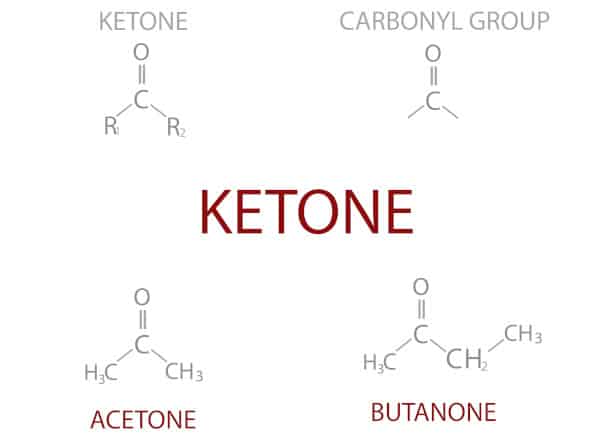
The principles of chemical incompatibility with CPVC
Ketones are a major class of chemicals known to be incompatible with CPVC. We’re not talking about the keto diet (though the chemical structure is similar) but rather powerful solvents. Foremost among these is acetone, which Miller Plastics explains can soften, smear, or even dissolve CPVC, PVC, and other plastics. Butanone is another common ketone. Both see everyday uses in lacquer, varnish, and paint remover.
A plasticizer is a substance that makes another material softer and more flexible. Like ketones, plasticizers can cause the deformation and failure of CPVC. As we mentioned earlier, plasticizers are in some types of caulk. But they can also be found in various soft-plastic products, which is why manufacturers caution not to use tape or insulated wires in contact with CPVC. Gaskets and hoses are other sources of plasticizers that can migrate into surrounding materials.
In general, organic solvents, including esters, ethers, furans, and alcohols, are also not recommended for use with CPVC. Ethers are used as solvents, in aerosols, as fuels, and in refrigeration, among other applications, and can have severe effects on thermoplastic pipes.
Aromatic hydrocarbons, including aromatic compounds like benzene, cyclohexane, and naphthalene, can all be very bad for CPVC. Long-chain hydrocarbons like hexanes and heptane are less harmful, though they should be used with caution as they can have smaller effects.
Oils are a mixed bag when it comes to CPVC—it all depends on the type of oil. Many sources reference edible oils as incompatible, which can be confusing. After all, we aren’t usually worried about dripping olive or canola oil onto plumbing or fire sprinkler pipes. Thus, focusing on the difference between ester and mineral oils is easier. Mineral oils, made from petroleum, are generally ok with CPVC. But ester oils, which can be synthetic or derived from vegetables, are not and can cause CPVC pipe problems.
Chemical compatibility by manufacturer
As a major COVC manufacturer, Lubrizol’s resources outlining chemical compatibility are extensive. The info in the company’s FBC System Compatible Program applies to BlazeMaster®, FlowGuard®, Corzan®, and Temprite® CPVC. Here is a list of Lubrizol-compatible products, and click here for incompatible products.
Spears® is another prominent CPVC manufacturer. It publishes a database of products known to be compatible with its FlameGuard®, LabWaste®, EverTuff®, and CTS offerings and a list of products and materials to be avoided without verifying their compatibility. You can also contact Spears Technical Services at (800) 862-1499 or email productsupport@spearsmfg.net with specific compatibility questions.
CPVC pipe problems can be avoided by following manufacturers’ instructions
CPVC pipes and fittings are some of the most useful and innovative materials employed in fire sprinkler systems. Light, flexible, and nearly corrosion-proof, they can simplify installation and maintenance wherever NFPA standards allow them. Nevertheless, media reports and legal actions may cause some people concern about whether CPVC is a strong, stable enough material.
Here’s the bottom line: installers must follow manufacturers’ instructions for safe storage, handling, and installation of CPVC pipes, including taking care to avoid exposure to incompatible chemicals. Installed correctly, CPVC pipes and fittings last and play their essential role in providing reliable fire protection.
Feel free to check out QRFS’s inventory of CPVC fittings and CPVC glue. If you have any questions, contact us at 888-361-6662 or support@qrfs.com.
This blog was originally posted at QRFS.com/blog. If this article helped you, check us out at Facebook.com/QuickResponseFireSupply or on Twitter @QuickResponseFS.


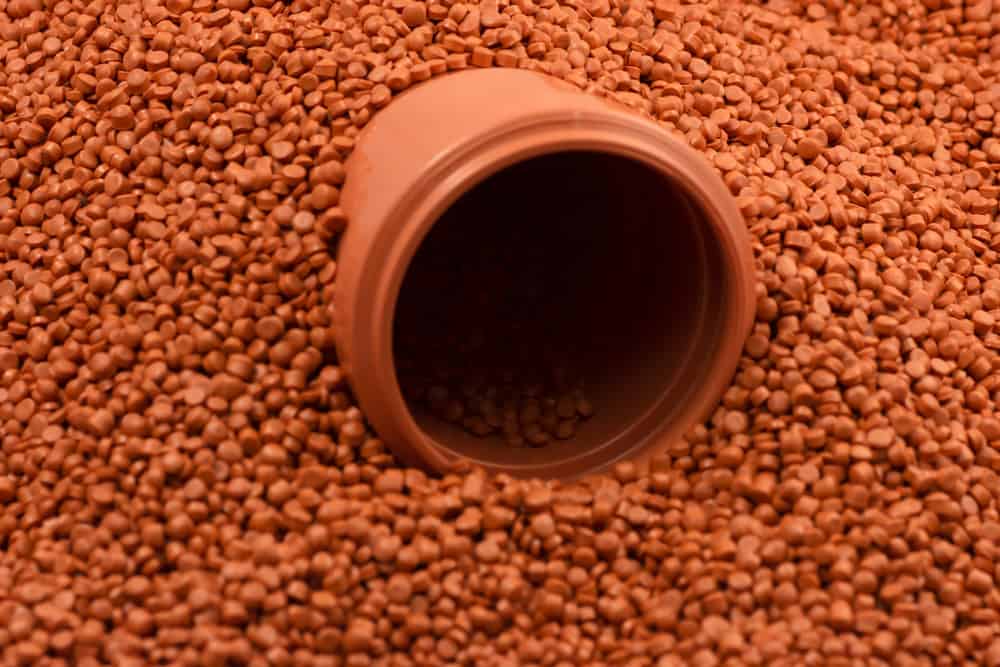
Is there a way to tell if exposure to chemicals on cpvc can be remediated?
Marlem — Your best course of action is to contact the specific CPVC manufacturer. In addition to having a definitive list of chemical incompatibilities, they can tell you the impact of exposure to a chemical. That said, it likely doesn’t take much for a chemical incompatibility to cause damage, and subtle damage that may show over time is not something you’d likely want to risk. Best of luck!